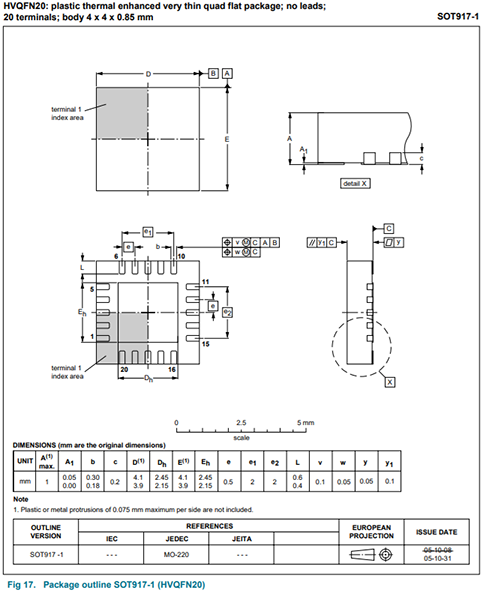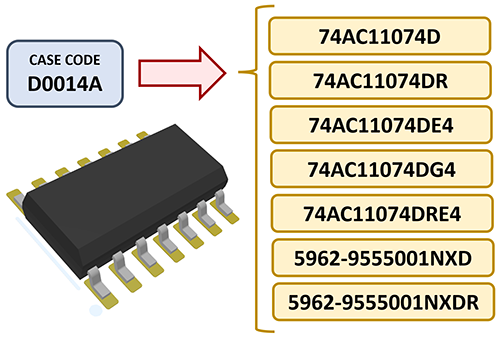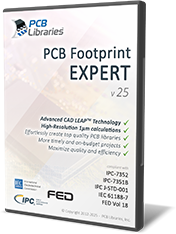

 |

|
PCBL Case Codes |
Post Reply 
|
| Author | |
Nick B 
Admin Group 
Joined: 02 Jan 2012 Status: Offline Points: 1947 |
 Post Options Post Options
 Thanks(0) Thanks(0)
 Quote Quote  Reply Reply
 Topic: PCBL Case Codes Topic: PCBL Case CodesPosted: 30 Mar 2025 at 4:57pm |
|
Component manufacturer Case Codes (Package ID's) are in the datasheet on the package dimension page. Every manufacturer has a unique case code for their specific package dimensions. If a Case Code does not exist for non-standard packages, the Part Number is used as a substitute. Sometimes discrete components will have a standard JEDEC or EIA Case Code for SODs, SOTs, Chips and Molded Body packages, but using the JEDEC and EIA Case Code name is misleading as every component manufacturer has slightly different dimensions than the JEDEC specifications. However, when a component manufacturer is acquisitioned by another manufacturer, the Case Codes could be changed. Sometimes the manufacturer Part Number includes the Case Code. Sample JEDEC Case Codes:
Sample EIA Case Codes:
All electronic devices today have unique Part Numbers but sometimes share the same Case Code. All connector Part Numbers are the Case Code, as all connector solder patterns are unique. Some component manufacturers provide good Case Codes. Here are examples of manufacturers that provide good Case Codes. NXP Semiconductor Case Codes start with SOD or SOT followed by a number. NXP refers to their Case Codes as 'Outline Version' and it's placed in the upper right corner of the component package dimensions page in the data sheet. Nexperia is a spinoff of NXP and they use the same SOD/SOT prefixes for their Case Codes. Here is the component package datasheet page with the Case Code SOT917-1 in the Upper Right.  Texas Instruments Case Codes were originally JEDEC descriptors. Example: D R-PDSO-G14 D = TI identifier, R = Rectangle, PDSO = Plastic Dual Small Outline, G = Gullwing with 14 leads When Texas Instruments acquired National Semiconductor, management preferred the NS Case Codes, so they are in the process of replacing all the JEDEC Case Codes with National Semiconductors. The original TI Case Code D R-PDSO-G14 was recently changed to D0014A. The D0014A Case Code is assigned to over 5,000 TI Part Numbers. Over the past 10 years, TI updated Case Codes for over 100,000 Part Numbers. If you're into creating large PCB library databases, you're constantly updating Part Numbers with new Case Codes. Here is a footprint and 3D model for TI Code D0014A.  Here is the component datasheet page with the Case Code in the Upper Left and package dimensions.
Analog Devices Case Codes start with 05-08-XXXX, but they also use Case Codes from their acquisition of Linear Technologies that begin with CP followed by a hyphen – and a number. Example: CP-10-9 Analog Devices also acquisitioned Maxim Integrated and took over their Case Codes that start with 21- followed by a 4-character numeric code 21-XXXX. Diodes, Inc. Case Codes include a variety of JEDEC, EIA and Component Family abbreviations like DFN, QFN, SOP, SOT, DPAK, SOD and DIP. However, be aware that Diodes, Inc. uses the same Case Code, but the packages have various dimensions like SOT23. This is because Diodes acquired ZETEX and their SOT23 used different package dimensions but still uses the same Case Code. The SOT23 Case Code can be spelled in different ways, and each version has different package dimensions. Examples: SOT23, SOT-23, SOT-23-3, SOT23 DN, SOT23F and SOT23R. On Semiconductor changed its name to onsemi. The Case Codes for onsemi start with the word "CASE" followed by a space and a sequence of alphanumeric characters. Example: CASE 318BA = SOT-23. Onsemi acquisitioned Fairchild Semiconductor which uses JEDEC and component family abbreviations but most of their Case Codes start with the letter M and followed be a string of alphanumeric characters. Example: MA03D = SOT-23. Infineon Technologies uses various techniques for Case Code names. JEDEC – PG-TO-2522-3, IR followed by numbers, P-TQFP-100-3, PG-DSO- (pin qty), PG- Component Family abbreviation (LGA, SOP, QFP, etc.). Infineon acquisitioned Cypress Semiconductor and added their Case Codes that start with 001- and 51- followed by 5 numeric characters. Example: 001-04468 = QFN and 51-85064 = QFP. Microchip Technology uses component family abbreviations and the pin quantity for their Case Codes. Examples: 8-SOIC, 64-QFN, 128-QFP, etc. They also use the prefix C04- followed by 3 numeric characters and the letter to represent the revision. Microchip acquisitioned Microsemi and incorporated their Case Codes that have a prefix of CASE followed by a letter. Microchip also acquisitioned Atmel and incorporated their Case Codes which begin with a number that represents the pin quantity followed by a random letter. Example: 86T = 86-pin SOP Cirrus Logic uses the component pin quantity + package abbreviation. Examples: 32L QFP, 44L PLCC, 48L QFN, 14L SOIC, 10L DFN. FTDI Chip uses the package abbreviation + pin quantity. Examples: QFP48, QFN32, VQFN48, WQFN28, SOP20, TSSOP20, SSOP20. Renesas Electronics uses L + pin quantity + overall package dimensions + version letter. Examples: L10 3x3B, L12 3x3D, L16 4x4A, L8 2x2C. They also use an M + pin quantity + .XX + version letter. Examples: M14.173A, M16.15A, M10.118, M28.209. Integrated Device Technology was acquired by Renesas, and they used a P + the Lead Shape G = Gullwing, J + J-Lead, L = PLCC + the package abbreviation. Examples: PG24 = SOP24, PJ28 = SOJ28, PL68 = PLCC68. Silicon Labs uses package abbreviation + pin quantity. Examples: DFN6, LGA42, QFP100, MSOP10, SOIC8, QFN20. They also use Si as a prefix followed by a random number. Examples: Si53306, SI32261, SI5338B, Si5395J. Wurth Elektronik uses a 9-character code for their part numbers, and the part number is also used as the Case Code. Examples: 749022011, 750313995, 750032052, etc. All the chip manufacturers use EIA Case Codes like 0201, 0402, 0603, 0805, 1206, etc. These manufacturers include AVX, Vishay, Yageo, Panasonic, KEMET, ROHM, KOA, Stackpole, Susumu, Ohmite. All connector manufacturers have unique part numbers and no Case Codes, so the Part Number is used as the Case Code. The connector footprint names are MfrNameAbreviation_MfrPartNumber. Non-standard Discrete and Semiconductor packages footprint names are always MfrNameAbreviation_CaseCode. The main issue is that component manufacturers should do a better job at creating unique Case Codes that represent their package dimensions. The package code should be located on the component dimensions page of every datasheet, and it should be obvious to every CAD librarian, PCB designer and EE engineer. The Case Code should be added to every schematic symbol and appear in every Bill of Material (BOM). Component manufacturers need to be aware that all PCB design layouts require solder patterns for every component package that they produce. Errors are created when manufacturers do not provide Case Code package IDs for all their package dimensions. The upside for assigning Case Codes (package IDs) for every component is that a CAD librarian only needs to spend time creating the Case Code solder pattern and then the EE engineer could assign a Part Number with the correct Case Code. Let's use Texas Instruments as an example for this concept. TI has 3,000 Case Codes and each one requires a unique solder pattern. This is what the PCB designer requires for the PCB layout. However, TI produces over 250,000 electronic device part numbers that map to the 3,000 Case Codes and that is a responsibility for the EE engineer. The PCB designer provides the Case Code to the EE engineer and the engineer assigns a part number with the correct manufacturer Case Code in the BOM. This will greatly enhance the productivity of the PCB designer and reduce errors, costs and turnaround time. Case Codes are a very important aspect of every electronic product.  PCB Footprint Expert To get a fully functional Footprint Expert license, complete the Evaluation License request on the Downloads page. Make sure to provide all the requested information, such as your company details and CAD outputs needed. Get your FREE Footprint Calculator or Footprint Expert Evaluation License: Call: 847-557-2300 |
|
 |
|
 |
|
Post Reply 
|
|
| Tweet |
| Forum Jump | Forum Permissions  You cannot post new topics in this forum You cannot reply to topics in this forum You cannot delete your posts in this forum You cannot edit your posts in this forum You cannot create polls in this forum You cannot vote in polls in this forum |